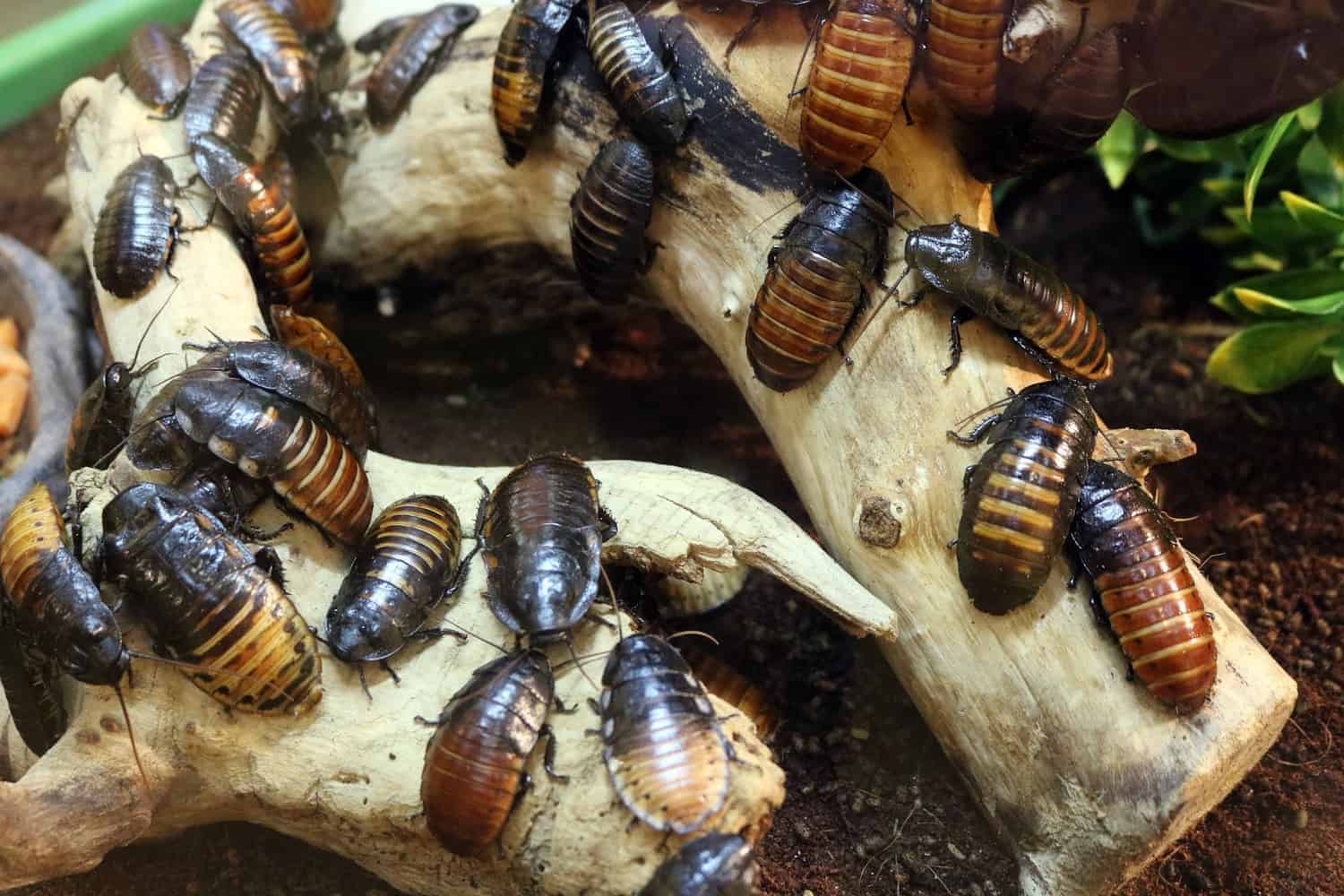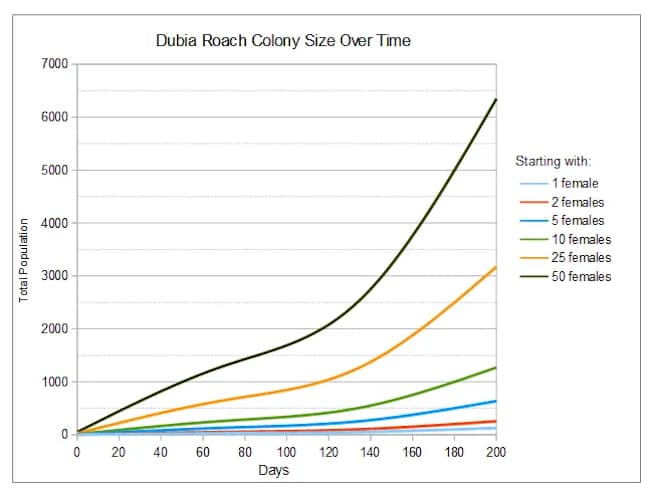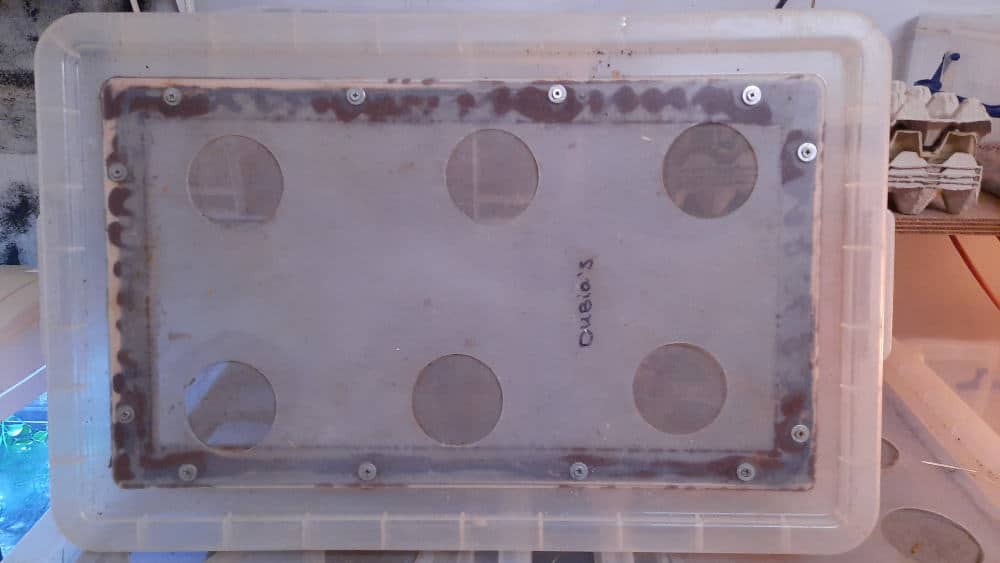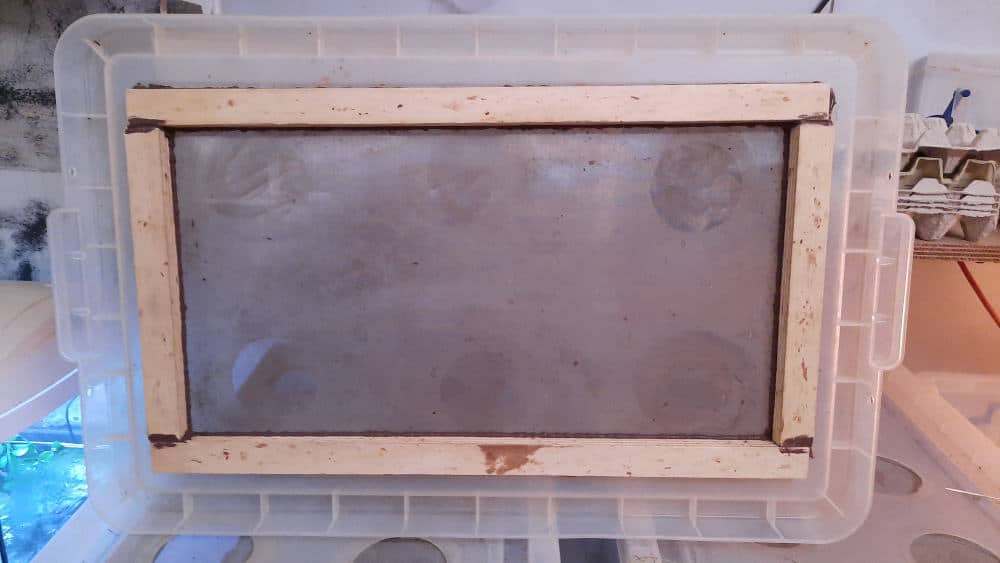Dubia roaches are very popular feeder insects. These roaches, also called Guyana orange spotted cockroaches, make an excellent food source. They are nutritious, large-sized and very well accepted by most animals. You can buy them from many suppliers, and they can often deliver them in large and constant quantities.
However, have you ever considered breeding them yourself? Or are you breeding dubia roaches now and want to improve your practice? Then you are in the right place. This page will guide you to the best approach to keep, care and breed dubia roaches so you’ll have your own supply of feeder insects. We will talk in this guide about housing, feeding, cleaning, and breeding them. Make yourself ready to breed your own feeder insects successfully.
Why dubia roaches?
There are about 4600 species described and known cockroaches. Foremost, many people know cockroaches as pests, but only five species are classified to become pests. However, they also make an excellent food source for many pet animals that need live food.
Several cockroaches are used as live food. The most popular and proven to be proper feeder insects are red runners (Shelfordella tartara), death’s head cockroaches (Blaberus craniifer), Madagascar hissing cockroaches (Gromphadorhina portentosa) and of course the dubia cockroach (Blaptica dubia). Why than prefer choosing the dubia roach to breed as feeder insect?
Breeding dubia roaches is preffered because:
- They are very easy to keep
- They don’t escape that easy (like red runners do)
- They don’t infest and become a pest that quickly (serious risk with red runners!)
- They breed pretty easy and relatively quick
- They are silent
- They do not smell
So, in this guide, we focus on keeping, caring and breeding dubia roaches. If you want to know more about keeping Madagascar hissing cockroaches (sometimes also used as feeder insect) you can read the ‘Madagascar hissing cockroach care sheet‘.
GOOD PRACTICE TIP: This guide will focus on keeping and breeding dubia roaches. However, most of this guide can be used for keeping and breeding other cockroaches as well. The basic principle will be the same. Adjust enclosure size and environmental conditions according to the species you want to keep.

Caution: Allergy warning!
One thing you should know from the start, and before you start breeding your own dubia roaches, is that allergic reactions have been recorded to (dubia) cockroaches, or their faeces, saliva or shedding body parts.
When you daily take care of them may result in the development of an allergic reaction. Keep attention to symptoms like an irritation to the skin or eyes, coughing, sneezing or nasal congestion when you are in proximity of dubia roaches.
When you start breeding them, I can highly recommend to use disposable latex gloves and face masks to prevent the risk of developing an allergy. It must also be said that people with asthma have known to be more and heavier affected to an allergic reaction.
How to house a dubia roach colony?
Proper housing is the first element to breed dubia roaches successfully. Housing makes sure that your dubia roaches can be kept in good conditions, and a suitable environment gives the best breeding productivity and outcome. It also prevents escapes and keeps your roaches contained in one place.
Before choosing a container to keep your dubia colony, you’ll need to pick a location to set up the breeding kit. The best place to set up your breeding container(s) is a location that has enough air circulation, has the correct ambient temperature and humidity, and is absent from frequent disturbances and loud noises which negatively influence the breeding result. So before buying first think of a good location where you can house your breeding colony.
The best conditions for the location to set up you breeding kit are:
- An ambient room temperature of 15°C and 25°C (60°F and 80°F)
- An ambient room humidity between 40 and 60%
- Good air circulation
- A darker place in the room, or absent of windows. Absolutely no direct sunlight on the enclosure
- Big enough to work comfortably and place your enclosures, but not too large of a space to manage.
Enclosure type and size
To house dubia roaches, your best option is to use plastic storage boxes. Preferably they are stackable and are included with a lid. Glass enclosures, like old aquariums and terrariums, can work. Still, plastic has more benefits over glass enclosures when used for breeding dubia roaches. Plastic boxes reduce heat loss, is lighter and won’t break. Therefore they are easier to work with, to move around and to clean. When you search for a suitable plastic container, some features are a must-have.
The plastic container should have smooth surfaces to prevent escapes of roaches. They shouldn’t have any textures are roughness on the sides. If the sides are shining or have a glance, you can assume you have a container where roaches don’t climb onto the sides.

Always buy a plastic container with a lid. Even if you don’t plan to use it, it may come in handy in the future when your setup changes or for other unforeseen circumstances because a lid is not necessary when you have smooth sides. However, a cover lid has the benefit to prevent unwelcome animals (pets or pests) and preventing stuff falls in. So I recommend using lids nonetheless.
Lids will close off the container, but also prevent further ventilation. So you’ll need to make an adjustment to the lid by creating ventilation holes. There is no such thing as too much ventilation in your enclosure, so make enough ventilation holes in the lid. After cutting out some ventilation holes, cover them with fine metal mesh and secure them with hot glue, or use a wood or metal frame. You better not use any fibreglass or plastic netting because roaches can and will chew through these materials.
How much dubia roaches you can house in one container depends naturally on the size of the enclosure. As a guide, I can say that you can house a maximum of 200 roaches on each 0,1m2 (1 sqft). Buy a plastic container that can house your planned amount of dubia roaches, but keep in mind not to buy an enclosure that is too large. It needs to stay manageable too. If you want to house a large number of dubia roaches, it would be better to house them over multiple enclosures, creating several breeding colonies.
GOOD PRACTICE TIP: When buying a plastic container to house your dubia roaches, you should immediately buy a second one! When there is something broken on your primary enclosure, you’ll have a back-up enclosure. Also, when cleaning the enclosure, it is much easier to move the colony to another (identical) enclosure than cleaning with your dubia colony inside of it.
Enclosure substrate and furniture
Let’s set up the breeding containers. The internal setup, the inside of the enclosure, is rather simple. It is built from three parts. On one side you have the food and water station. On the other side, you have the shelter for the dubia roaches.
And what about substrate then? You don’t need to add substrate to the enclosure. In fact, it doesn’t add any perk and make cleaning of the enclosure only more complicated and time-consuming.
Paper egg flats are typical to use to create a shelter for the dubia roaches. There is nothing that works equally as egg flats to house and shelter dubia roaches. They are liked because of the rough texture and when placed together create tide spaces that are favoured by roaches. Next to that, it creates an additional surface to house more dubia roaches. Other materials that can be used are paper, carton boards, and paper rolls. However, nothing works that great as egg flats.
You’ll have the best benefit of egg flats when placed and packed vertically side to side. When positioned this way, faeces fall to the bottom and keep eggs flats clean, and it prevents the accumulation of moisture. And from experience, when placing egg flats vertically, it seems like roaches don’t chew through the carton that quickly. Make sure that when egg flats are placed vertically, it doesn’t touch the top (lid) of the enclosure. You can cut them, so it fits better.
Egg flats are made in such a way that they fold together when you stack them. To create the right spaces between the egg flats, you need to turn each consecutive flat 90-degrees or place them in a reverse direction: front-to-front and the next one back-to-back.
Creating enough shelter is crucial to stimulate breeding, but keep it separated from the food and water station. This way, the food station does not make the shelter dirty and wet and keeps the food and water station cleaner. It also makes it easier to refresh their food and water.
How to create the best breeding environment?
Environmental conditions have a considerable influence on the breeding outcome of dubia roaches. Temperature and humidity need to be perfect to stimulate high breeding productivity, which ultimately is the main reason you have them. Next to that, it is important where you place the containers, and it is also essential to create the best breeding environment inside the container.
Temperature and heating
Cockroaches are harsh animals, surviving many climates. But for the best breeding result, the conditions are rather narrow. Temperature is one of the more essential factors influencing breeding. Fertility rapidly decreases to non when you keep them outside the temperature range of 28°C and 32°C (85°F and 90°F).
Lower temperatures make the dubia roaches slower. When too hot, and above 32°C (90°F), will ultimately cause heat stress and may result in the death of many roaches.
It is not likely you’ll have a place or a room that is kept on that temperature continuously, so you’ll need to add additional heating to create this temperature range inside the enclosure. Next to that, it is better to place them in a room that has an ambient temperature at least a bit lower than the local temperature to create better air circulation.
Heating can be done in mainly three two ways: top heating and bottom heating. To explain this a little further, you can heat an enclosure by placing a heat source above the enclosure or under the enclosure. It does not matter what heating source you choose, except that you need to place the heating source outside the enclosure. This prevents contact burning of roaches on the heating source or overheating.
Because dubia roaches do like the dark, I recommend to use a heat mat (also called heat pads) and place it under the enclosure. It evenly distributes the heat in the enclosure and doesn’t get too hot, causing the plastic to melt. Also, because you’ll need to work from the top of the container, the heat source is not in the way, and you have free space to do the daily care.
Read more about temperature and heating in the basics guide.
Humidity and drinking water
Your dubia roaches will have the best breeding result when you keep them between 40% and 60% relative humidity with more on the higher end of the scale. A higher level of humidity is still acceptable, to a certain level, but you should always avoid lower humidity levels.
When humidity drops under 40%, it may cause that ootheca (egg capsules) and nymphs will dry out. This result in the infertility of female roaches. Also, with low humidity, roaches have more difficulties shedding their old skin. Too high humidity, especially higher than 80% for a more extended period, may cause problems too. A very humid environmental, together with high temperatures, and the presence of frass, will quickly result in the rapid growth of mould and bacteria. Roaches, and especially the eggs and nymphs, are very sensitive to mould and bacteria.
Dubia roaches, like all other animals, need drinking water. Dubia roaches need to be kept hydrated. This is especially true for nymphs, which immediately need water when hatched. Water is absorbed from fresh food items, but also need to be provided and refreshed daily.
It is not a good idea to just offering a regular water bowl because this will quickly result in the drowning of roaches (particular nymphs). When you use a water bowl, make sure it is shallow, have rough edges and is filled with a spongy material to prevent drownings. When you use standard sponges, make sure they are free of any chemicals. Better would be to use aquarium filter sponges.
Water crystals are also used to hydrate dubia roaches. This absorbent polyacrylamide hydrogel absorbs water and safely release it to roaches without the risk of drowning. However, to keep them in good shape and fresh is more work than a typical water bowl with a sponge. When you do not give enough attention, water crystals can rot or lead to other problems. Personally, I’m not too fond of the use of water crystals; however, many people use them and are entirely convinced of them.
You can read more about humidity and drinking in the basics guide.
Monitoring and automating
Monitoring the environment of the container is important to make sure it suits the needs of your roaches. Using a thermometer and hygrometer (often available in one device) make sure that you have the correct temperature and humidity. Such a device are widely available and are relatively cheap, so there is nothing to lose on this end.
Using a thermostat switch, make sure your heating source will not overheat your enclosure. These devices are also widely available and easy to purchase. And they don’t have to be that expensive. You can buy a simple model already for $25 on amazon. Thermostat switches are also beneficial for back-up heating systems. When the primary heating system fails, and the temperature drops below a certain threshold, the thermostat switch on your back-up heating to keep the temperature somewhat at the right level.
Cleaning
Cleaning of the containers has to be done regularly. Don’t be afraid; cleaning is pretty straightforward. Because we don’t use any substrate, you can easily remove any dirt. While cleaning, you’ll need to remove the excessive frass, shedding skins, food remains and dead roaches. It should be done at least every other day, but because you’ll need to feed them any way you can easily do the cleaning at the same time.
Always keep some of the frass (roaches faeces) left in the container. Newborn nymphs will eat from the frass and often hide in it. If you clean your container too much will kill or negatively influence the development of your nymphs.
Once in a while, you’ll need to clean more extensively. When you do, make sure you only clean with (hot) water. Any chemicals and cleaning products are harmful and often lethal to dubia roaches. When you need to clean the entire enclosure, it is easier to move the dubia colony to another (temporary) container.
What to feed dubia roaches?
Dubia roaches are opportunistic and scavenge all food they can find. They have simplistic basic needs and therefore eat almost anything you feed them. That does not mean you should feed them anything. Only provide your dubia roaches what you want to feed the animals that ultimately eat the dubia roaches as food.
So, what should you feed dubia roaches? A proper diet of dubia roaches consists of primarily vegetables and fruit, supplemented with some protein-based products like whole-grain bread, cereal grains and oats. They have a preference for orange foods like oranges and carrots. Give them enough variation of products to keep them healthy and providing all essential nutrients.
Dubia roaches have a survival strategy to be very efficient with processing and storing proteins. They can store proteins that they don’t immediately need for later use in the form of uric acid. Uric acid is toxic in high levels and may cause problems when you feed dubia roaches with high levels of it to other animals. To prevent this build-up of uric acid in their bodies don’t feed them high levels of proteins. A level of 25% of proteins in the diet seems like an ideal level. Additionally, provide enough freshwater because it appears like hydration help reduce the uric acid level too.
There is a myriad of preformulated insect diets available to feed to your insects. However, most of them are too high in protein for dubia roaches. It is not particularly necessary to provide them preformulated diets, but when you do, choose the ones that are developed to feed dubia roaches primarily.
Breeding dubia roaches
Now we will focus on the breeding of dubia roaches itself. That is, of course, the ultimate goal to achieve. Breeding dubia roaches is rather easy, and when done the previous steps (provide suitable housing and environment) will generally make them breed perfectly well. But first, let’s look at the life cycle of dubia roaches before we will look at starting a breeding colony and improve breeding productivity.
Dubia roach life cycle
Dubia roaches are exceptionally long-lived insects when you compare them with other feeder insects. Females may live up to 24 months, and males live a bit shorter with 18 months.
QUICK TIP: You can easily spot the difference between male and female roaches. Males have full-grown wings when reaching adulthood, whereas females have underdeveloped wings.
Egg/ootheca
Dubia roaches are ovoviviparous, which means that the eggs hatch inside the female just before giving birth. The egg capsule containing the eggs is called an ootheca. Females give birth of 20 to 40 nymphs every 65 days when kept in favourable conditions, but the average is more around 25 nymphs.
Nymph
Dubia roaches belong to the hemimetabolous insects which means they go through a series of several nymphal stages — called instars — before reaching adulthood. When newly hatched the nymph is 2mm in length. They mature in about 4 to 6 months, but this depends on the temperature and available food supply. Within this maturing process, the nymphs go through 7 nymphal stages and with every moult grow about 25%.
Adult
Adult male and female roaches will begin mating almost immediately when reaching adulthood. They mate preferably, and also give birth, in dark places like the hiding places you provided. Nearly every 65 days, a female will give birth again, which mean the colony will grow exponentially when the next generation reaches adulthood.

Starting a dubia roach colony
You are now ready to start your own dubia roach breeding colony. You can buy your first dubia roaches at an animal pet store or commercial feeder insect breeder. They usually are sold as feeder roaches, but naturally, these roaches can also be used as the start for your colony.
If you want to start a small breeding setup, an amount of 20 breeding female roaches should be sufficient. If you have many animals that you want to feed dubia roaches, you’ll need more like 50 up to 100 breeding females.
It takes some time to create a stable and self-sustaining breeding colony. You’ll need multiple generations of dubia roaches to be able to replace the breeding roaches that are died of age.
How to breed dubia roaches faster?
A question often asked is how to breed dubia roaches faster or to get more breeding outcome. Factors that are influencing the breeding productivity of dubia roaches are temperature, male to female ratio, overcrowding, replenishment of adults in the colony and good care of nymphs.
- Temperature is crucial: temperature is one of the most important factors in breeding dubia roaches. When it is not in the optimal range (between 25°C and 30°C) will negatively influence the breeding productivity. Check if the temperature of your enclosure is in this range.
- Male to female ratio: a correct male to female ratio is evenly important. You’ll need more females than males in your breeding colony. The optimal male to female ratio lies between 1:3 to 1:7.
- Prevent overcrowding: overcrowding, with other words too many roaches in one enclosure negatively influence the breeding result. When you want to house more dubia roaches divide them into two separate enclosures.
- Replenish breeding colony: Eventually, your founding dubia roaches will die of age. If you do not replenish your adults with ones from your own breeding, there will be less and less adults that can produce new offspring. Try to keep a base amount of adults in your colony.
- Extra care for nymphs: Make sure that also the nymphs have all the care they need. If they die early on, or their development is slowed down, you have fewer roaches to feed and ultimately slow down your whole breeding result.
Other bugs you can keep as a pet
Although cockroaches are amazing pets, there are many other bugs that make great pets too. Check out the bugs below, maybe you find them even more interesting to keep.
– Praying mantises
– Millipedes
– Beetles
– Ant colony
– Tarantulas
Share this page!


